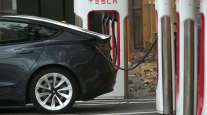The Detroit News
Ford Eyes EV Market Leadership With Launch of F-150 Lightning

[Stay on top of transportation news: Get TTNews in your inbox.]
Ford Motor Co. is officially planting its flag with the launch of an all-electric version of America’s best-selling truck, aiming to overtake Tesla Inc. and lead the electric vehicle market.
Blue Oval brass said as much during the F-150 Lightning’s formal launch April 26 at Detroit’s Rouge Electric Vehicle Center, a new EV manufacturing facility at Ford’s historic Rouge complex that already has been expanded to boost production capacity to 150,000 units annually. The event highlighted the symbolic resonance of the Rouge, the employees building the Lightning, customers (some of whom were invited) and the automaker’s electric ambitions.
“We have every intention of being the No. 1 electric pickup maker,” CEO Jim Farley said. “And then, with the huge investments — $50 billion in EVs, battery manufacturing, our expanded lineup which you have not seen yet — we plan to challenge Tesla and all comers to become the top EV maker in the world.
“That’s something that no one would have believed just two years ago from us. Take a look at this truck and believe it.”
Lightnings will begin shipping to customers in the next few days, Farley said, starting with the Ford Pro model aimed at commercial customers. That’s where the rubber meets the road.
“More and more customers over the next several weeks are going to start getting their Lightnings. And that’s going to be the real test of how people really feel about an electric truck,” said Sam Abuelsamid, an autos analyst at Guidehouse Insights.
This moment is every bit as important to this company and to this country as when the Model T first started rolling off the assembly line.
Ford Executive Chairman Bill Ford
“This is going to be the first really high-volume electric truck,” he added. “And because of the segment that this is in — this is the most popular segment in the US market — the response to this vehicle is going to be a great indicator of how the American consumer is going to take to EVs over the coming years.”
For Stanton Hunter of New Jersey, the Lightning will be his first pickup truck as well as his first EV. He has a Lightning on order, with a build date scheduled in June, and was among the customers Ford invited to the launch.
“I’ve always wanted a pickup truck,” Hunter said. “But gas mileage was never really agreeing with me. So I decided that this is probably the best time to do it.”
Underscoring one possible challenge now facing Ford, though: Hunter initially planned to buy a Bronco SUV, which Ford resurrected last year, but he was so far down the reservation list that he jumped over to the Lightning when orders for the truck opened.
Already, Ford executives have repeatedly said the company is oversubscribed on its first wave of EVs. The automaker capped reservations on the Lightning after they got 200,000, and the 2022 model year is no longer available for retail orders. Model year 2023 order bank (for existing reservation holders) will open in the summer for deliveries in the fall.
Ford Executive Chairman Bill Ford acknowledged that it’s a bit of a dilemma, saying that he recently talked with would-be Bronco customers at an event in Texas who are still waiting for build dates for their vehicles.
“So it’s really across a lot of our hot products, and we’re doing everything we can to try and communicate with them,” he said. “We probably need to do a better job of that.”
But between the coronavirus pandemic, demand exceeding supply for raw materials needed for EV batteries, an ongoing global semiconductor chip shortage and other supply chain issues, production has been constrained.
“The good news is, there’s tremendous demand for our products, but it is frustrating that we can’t build them in a timely fashion. Our team has done a great job of breaking bottlenecks, but then new ones pop up,” Bill Ford said. “That’s just the world we’re in, unfortunately. But we don’t want to lose those customers. We don’t them to walk away, and we’re doing everything we can to accommodate them.”
He also acknowledged that the company is “looking” at investing further down the supply chain to shore up the minerals needed to build batteries.
Production constraints aside, Ford executives on April 26 struck an upbeat note about what an electric F-150 means for the future of not just the company, but the country as a whole.
“This moment is every bit as important to this company and to this country as when the Model T first started rolling off the assembly line,” Bill Ford said. “Back then, we were the first company to bring automobiles to everybody. Now, we’re the first company to build electric trucks for everybody — way ahead of anyone else.”
Ford’s F-Series truck lineup has been the best-selling vehicle in America for 45 years. And executives touted the Lightning as a work truck that’s capable of everything its gas-powered sibling is — and more. Farley highlighted benefits such as instant torque, an onboard generator, the “frunk” (or, front trunk) that offers 14.1 cubic feet of cargo volume, and over-the-air software updates — “like a smartphone that can tow 10,000 pounds.”
The mainstream appeal of F-Series, as well as the enhancements promised by an electric version, are what have some sustainability advocates excited.
“I think the F-150 going electric is a big old flag in the sand of EVs meet you where you are. You don’t have to come to them,” said Dave Mullaney, principal of carbon-free mobility at RMI, a nonprofit focused on decarbonization and other energy issues.
The electrification of the F-150 is “huge,” in Mullaney’s estimation, because of the impact it could have on truck fleets — but also on the average consumer, who up until recently didn’t have any electric truck options.
“It’s a key inflection point for the electric vehicle itself,” he said.
Pricing for the F-150 Lightning starts at about $40,000. The truck can go up to 320 miles on a single charge, per EPA estimates, and has targeted maximum payload of 2,000 pounds.
“Our customers are going to get capabilities no other EV truck can ever offer,” said Farley. “But for thousands of dollars less than our competitors’ trucks — whenever they actually go on sale.”

Lightning order holder Emre Gol gives an interview to a Detroit TV station. (WXYZ-TV)
Overall, Ford now is targeting annual EV production of 600,000 units by next year, and 2 million by 2026.
Crosstown rival General Motors Co. plans to introduce 30 new EVs globally by 2025, and targets production of 400,000 EVs in North America this year and next. It expects to have 1 million units of EV capacity in North America by the end of 2025. An all-electric Chevy Silverado pickup — which GM reported April 26 has garnered 140,000 reservations — is slated to launch next year.
Meanwhile, Lightning order holder Emre Gol plans to use his electric truck for work. He owns a remodeling business and said it’s not uncommon to drive 250 miles a day traveling across the Houston area. He currently drives a Tesla Model 3 and enjoys the savings on fuel and maintenance.
“EVs are the way to go,” he said. “We use these things for work.”
Want more news? Listen to today's daily briefing below or go here for more info:
Distributed by Tribune Content Agency, LLC





